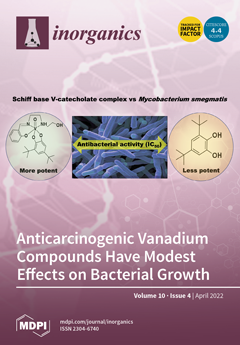Schiff bases have played significant roles in the development of inorganic or coordination chemistry. Three Schiff base (NB, CB and HB) ligands, prepared for the reaction of 2-amino-6-methoxy-benzothiazole with 2-Nitrobenzaldehyde, 2-chlorobenzaldehyde and 2,4-Dihydroxybenzaldehyed, respectively, were investigated for their transition metal complexes, which were
[...] Read more.
Schiff bases have played significant roles in the development of inorganic or coordination chemistry. Three Schiff base (NB, CB and HB) ligands, prepared for the reaction of 2-amino-6-methoxy-benzothiazole with 2-Nitrobenzaldehyde, 2-chlorobenzaldehyde and 2,4-Dihydroxybenzaldehyed, respectively, were investigated for their transition metal complexes, which were prepared by reacting the ligand (2:1 molar ratio) with Co(II), Ni(II), Cu(II), Cd(II), Cr(III) and Fe(III) chlorides. The nature of the interaction between the metal ions and ligands (L) was studied with the aid of magnetic susceptibility, elemental analysis, FTIR and
1H-NMR spectroscopy. Based on the magnetic superstability and elemental analysis results, octahedral structures of the complexes, such as [ML
2Cl
2] or [ML
2Cl(OH)], were proposed for Cu(II), Cd(II), Co(II) and Ni(II) in which the ligand (L:NB, CB or HB) is bidentate through the azomethine and benzothiazole nitrogen. For Cr(III) and Fe(III) complexes, octahedral ML
2Cl(OH)
2 or ML
2(OH)
3 structures were proposed, where one ligand is monodentate and the other is bidentate. The azomethine ν(-HC=N-) and
1H-NMR peaks of NB and CB were shifted to a higher frequency and downfield, respectively, upon complexation with metal ions. The bonding of OH groups of HB to Co(II), Cu(II) and Ni(II) enables π-backdonation from these metals to the azomethine of Schiff bases and the consequent shift of ν(-HC=N-) to a lower frequency and changes in the intensity of the
1H-NMR peak of OH. On the other hand, this backdonation was not evidenced in the FTIR of HB complexes with high-charge Cr(III) and Fe(III) ions.
Full article





